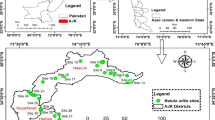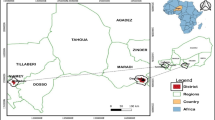Abstract
Climate change can result in a slow disappearance of forests dominated by less drought-tolerant native European beech (Fagus sylvatica) and oak species (Quercus spp.) and further area expansion of more drought-tolerant non-native black locust (Robinia pseudoacacia) against those species in Hungary. We assumed that the shift in plant species composition was modified by selective ungulate browsing. Thus, we investigated which woody species are selected by browsing game. We have collected data on the species composition of the understory and the browsing impact on it in five different Hungarian even-aged forests between 2003 and 2005. Based on these investigations the non-native Robinia pseudoacacia living under more favourable climatic conditions was generally preferred (Jacobs’ selectivity index: D = 0.04 ± 0.77), while the native Fagus sylvatica and Quercus spp. (Q. petraea, Q. robur), both more vulnerable to increasing aridity, were avoided (D = −0.37 ± 0.11; −0.79 ± 0.56; −0.9 ± 0.16; respectively) among target tree species. However, economically less or not relevant species, e.g. elderberry (Sambucus spp.), blackberry (Rubus spp.) or common dogwood (Cornus sanguinea) were the most preferred species (D = 0.01 ± 0.71; −0.12 ± 0.58; −0.2 ± 0.78, respectively). Our results imply that biodiversity conservation, i.e. maintaining or establishing a multi-species understory layer, can be a good solution to reduce the additional negative game impact on native target tree species suffering from drought. Due to preference for Robinia pseudoacacia selective browsing can decelerate the penetration of this species into native forest habitats. We have to consider the herbivorous pressure of ungulates and their feeding preferences in planning our future multifunctional forests in the light of climate change impacts.

Similar content being viewed by others
References
Apollonio M, Andersen R, Putman R (2010) Present status and future challenges for European ungulate management. In: Apollonio M, Andersen R, Putman R (eds) European ungulates and their management in the 21st century. Cambridge University Press, Cambridge, pp 578–604
Barrett RP, Mebrahtu T, Hanover JW (1990) Black locust: a multi-purpose tree species for temperate climates. In: Janick J, Simon JE (eds) Advances in new crops. Timber Press, Portland OR, pp 278–283
Benesperi R, Giuliani C, Zanetti S, Gennai M, Lippi MM, Guidi T, Nascimbene J, Foggi B (2012) Forest plant diversity is threatened by Robinia pseudoacacia (black-locust) invasion. Biodivers Conserv 21:3555–3568
Berki I, Rasztovits E, Móricz N, Mátyás Cs (2009) Determination of the drought tolerance limit of beech forests and forecasting their future distribution in Hungary. Cereal Res Commun 37:613–616
Biró Zs, Szemethy L, Katona K, Heltai M, Pető Z (2006) Seasonal distribution of red deer (Cervus elaphus) in a forest–agriculture habitat in Hungary. Mammalia 70(1–2):70–75
Bleier N, Lehoczki R, Újváry D, Szemethy L, Csányi S (2012) Relationships between wild ungulates density and crop damage in Hungary. Acta Theriol 57(4):351–359
Boulanger V, Baltzinger C, Saïd S, Ballon P, Picard J-F, Dupouey J-L (2009) Ranking temperate woody species along a gradient of browsing by deer. For Ecol Manage 258:1397–1406
Burbaité L, Csányi S (2009) Roe deer population and harvest changes in Europe. Est J Ecol 58(3):169–180
Byers CR, Steinhorst RK, Krausman PR (1984) Clarification of technique for analysis of utilization-availability data. J Wildl Manage 48:1050–1053
Cairns DM, Moen J (2004) Herbivory influences tree lines. J Ecol 92:1019–1024
Côté SD, Rooney TP, Tremblay J-P, Dussault C, Waller DM (2004) Ecological impacts of deer overabundance. Annu Rev Ecol Evol Syst 35:113–147
Csányi S, Lehoczki R (2010) Ungulates and their management in Hungary. In: Apollonio M, Andersen R, Putman R (eds) European ungulates and their management in the 21st century. Cambridge University Press, Cambridge, pp 291–318
Czúcz B, Gálhidy L, Mátyás C (2011) Present and forecasted xeric climatic limits of beech and sessile oak distribution at low altitudes in Central Europe. Ann For Sci 68(1):99–108
Didion M, Kupferschmid AD, Wolf A, Bugmann H (2011) Ungulate herbivory modifies the effects of climate change on mountain forests. Clim Chang 109:647–669
FVM (Ministry of Agriculture and Rural Development) (2008) A Nemzeti Erdőprogram 2006–2015. évi megvalósításának terve a Kormány 1110/2004. (X. 27.) Korm. határozatának 3. pontja alapján. Ministry of Agriculture and Rural Development, Budapest (In Hungarian)
Gálos B, Lorenz Ph, Jacob D (2008) Will dry events occur more often in Hungary in the future? Environ Res Lett 2:034006
Gebert C, Verheyden-Tixier H (2001) Variations of diet composition of red deer (Cervus elaphus L.) in Europe. Mammal Rev 31(3):189–201
Gill RMA, Beardall V (2001) The impact of deer on woodlands: the effects of browsing and seed dispersal on vegetation structure and composition. Forestry 74(3):209–218
Herrero A, Zamora R, Castro J, Hódar JA (2012) Limits of pine forest distribution at the tree line: herbivory matters. Plant Ecol 213:459–469
IPCC (2007) Summary for policymakers. In: Solomon S, Qin D, Manning M, Chen Z, Marquis M, Averyt KB, Tignor M, Miller HL (eds) Climate change 2007: the physical science basis. contribution of working group I to the fourth assessment report of the intergovernmental panel on climate change. Cambridge University Press, Cambridge, pp 1–18
Jacobs J (1974) Quantitative measurement of food selection. A modification of the forage ratio and Ivlev’s electivity index. Oecologia 14:413–417
Kauhala H, Auttila M (2010) Estimating habitat selection of badgers—a test between different methods. Folia Zool 59(1):16–25
Kleinbauer I, Dullinger S, Peterseil J, Essl F (2010) Climate change might drive the invasive tree Robinia pseudacacia into nature reserves and endangered habitats. Biol Conserv 143(2):382–390
Kramer K, Groot Bruinderink GWTA, Prins HHT (2006) Spatial interactions between ungulate herbivory and forest management. For Ecol Manage 226:238–247
Lakatos F, Molnár M (2009) Mass mortality of beech on Southwest Hungary. Acta Silvatica et Lignaria Hungarica 5:75–82
Mátrai K, Kabai P (1989) Winter plant selection by red and roe deer in a forest habitat in Hungary. Acta Theriol 34:227–234
Mátrai K, Katona K, Szemethy L, Orosz Sz (2002) Quantitative and qualitative characteristics of red deer diet during vegetation period in a lowland forest, Hungary. Vadbiológia 9:1–10 (In Hungarian with an English summary)
Mátrai K, Szemethy L, Tóth P, Katona K, Székely J (2004) Resource use by red deer in lowland nonnative forests, Hungary. J Wildl Manage 68:879–888
Mátyás Cs (2010) Forecasts needed for retreating forests (opinion). Nature 464:1271
Mátyás Cs, Czimber K (2000) Modelling of zonal forest cover: possibilities for forecasting climate change effects. In: Kircsi A (ed) Third conference on forest and climate. Kossuth University Press, Debrecen, pp 83–97 (In Hungarian with an English summary)
Mátyás Cs, Vendramin GG, Fady B (2009) Forests at the limit evolutionary-genetic consequences of environmental changes at the receding (xeric) edge of distribution. Ann For Sci 66:800–803
Milad M, Schaich H, Bürgi M, Konold W (2011) Climate change and nature conservation in Central European forests: a review of consequences, concepts and challenges. For Ecol Manag 261:829–843
Milad M, Schaich H, Konold W (2012) How is adaptation to climate change reflected in current practice of forest management and conservation? A case study from Germany. Biodivers Conserv. doi:10.1007/s10531-012-0337-8
Milner JM, Bonenfant C, Mysterud A, Gaillard JM, Csányi S, Stenseth NC (2006) Temporal and spatial development of red deer harvesting in Europe: biological and cultural factors. J Appl Ecol 43:721–734
Neu CV, Byers CR, Peek JM (1974) A technique for analysis of utilization-availability data. J Wildl Manage 38(3):541–545
Nugent G (1990) Forage availability and the diet of fallow deer (Dama dama) in the Blue Mountains, Otago. New Zeal J Ecol 13:83–95
Putman RJ, Moore NP (1998) Impact of deer in lowland Britain on agriculture, forestry and conservation habitats. Mammal Rev 28(4):141–164
Richardson DM, Rejmánek M (2011) Trees and shrubs as invasive alien species—a global review. Divers Distrib 17:788–809
Scientific Expert Group on Climate Change (SEG) (2007) In: Bierbaum RM, Holdren JP, MacCracken MC, Moss RH, Raven PH (eds) Confronting climate change: avoiding the unmanageable and managing the unavoidable. Report prepared for the United Nations Commission on sustainable development. Sigma Xi, Research Triangle Park and the United Nations Foundation, NC and Washington, DC
Sitzia T, Campagnaro T, Dainese M, Cierjacks A (2012) Plant species diversity in alien black locust stands: a paired comparison with native stands across a north-Mediterranean range expansion. For Ecol Manag 285:85–91
Szemethy L, Mátrai K, Biró Zs, Katona K (2003a) Seasonal home range shift of red deer in a forest–agriculture area in southern Hungary. Acta Theriol 48:547–556
Szemethy L, Mátrai K, Katona K, Orosz Sz (2003b) Seasonal home range shift of red deer hinds Cervus elaphus: are there feeding reasons? Folia Zool 52(3):249–258
Winnett SM (1998) Potential effects of climate change on U.S. forests: a review. Clim Res 11:39–49
Wisnovszky K (ed) (2011) Forest resources, forestry and wood management in Hungary. Central Agricultural Office, Forest Directorate, Budapest
Acknowledgements
We are grateful to Katalin Mátrai, Zsolt Biró and the other colleagues and students for participating in field works. Zoltán Somogyi provided us valuable comments and information. James Dedon revised the final English version of the manuscript. The Gemenc, SEFAG Forestry and Timber Industry and Egererdő joint-stock companies made the investigations possible on their areas. The work was funded by the Game Management Foundation of the Ministry of Agriculture and Rural Development (FVM 73028/2002). This paper was supported by the János Bolyai Research Scholarship of the Hungarian Academy of Sciences (to Katona, K.) and the Research Faculty Grant of the Hungarian Ministry of Human Resources (7629-24/2013/TUDPOL).
Author information
Authors and Affiliations
Corresponding author
Rights and permissions
About this article
Cite this article
Katona, K., Kiss, M., Bleier, N. et al. Ungulate browsing shapes climate change impacts on forest biodiversity in Hungary. Biodivers Conserv 22, 1167–1180 (2013). https://doi.org/10.1007/s10531-013-0490-8
Received:
Accepted:
Published:
Issue Date:
DOI: https://doi.org/10.1007/s10531-013-0490-8




